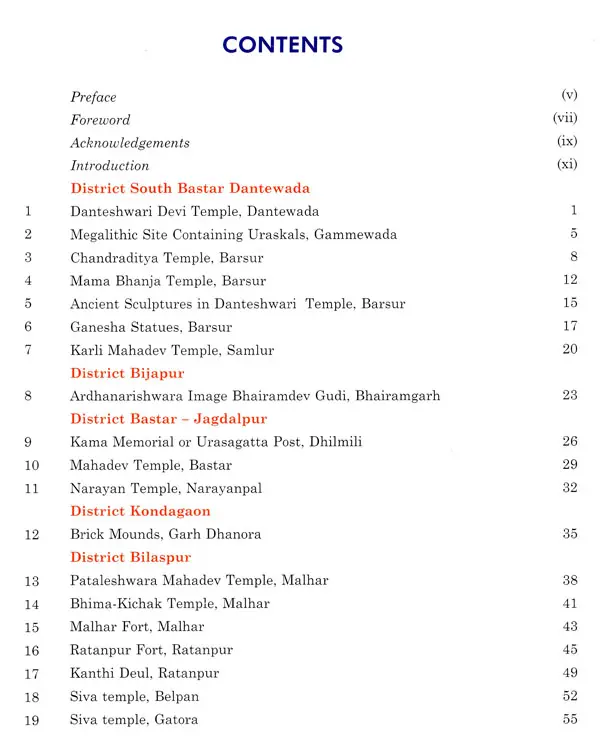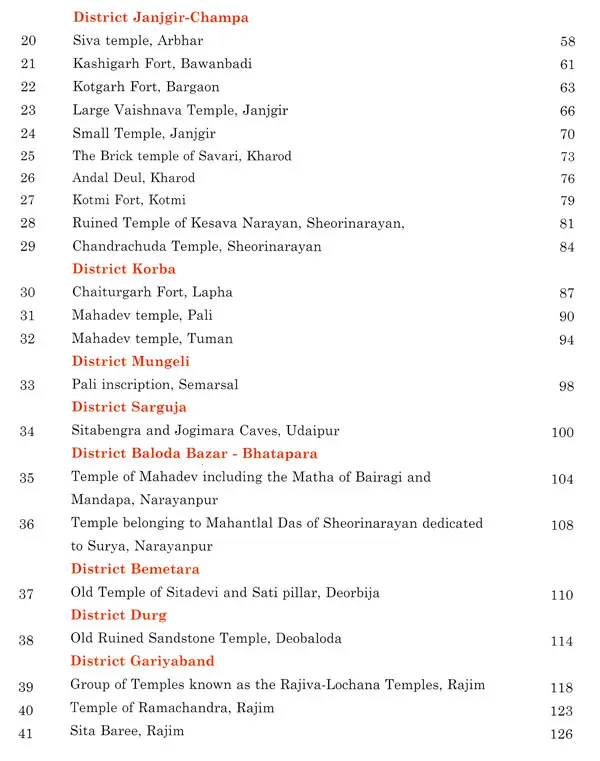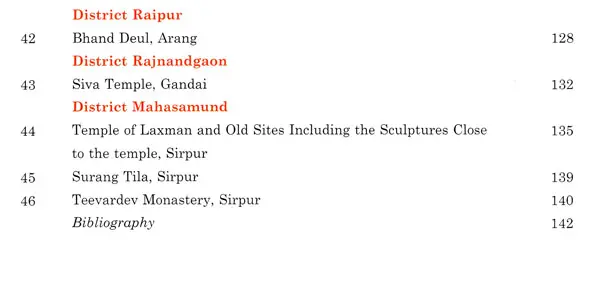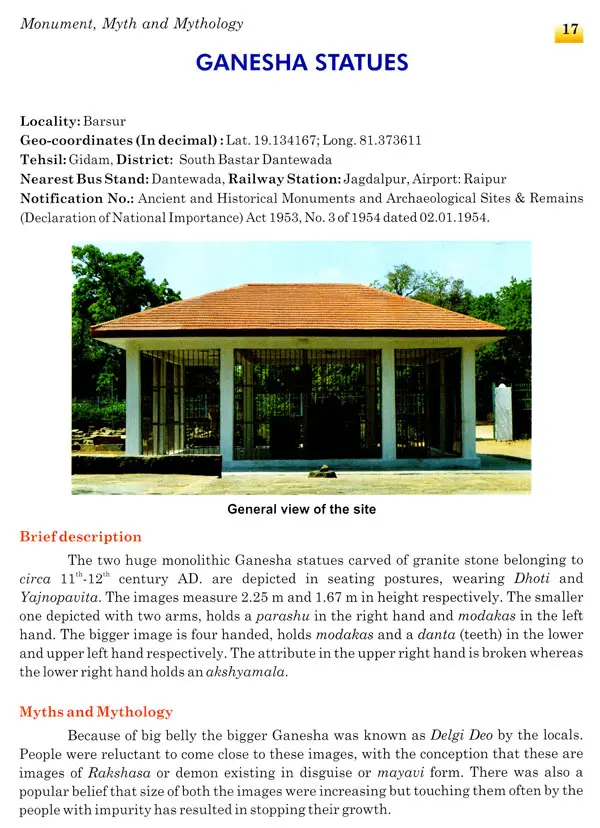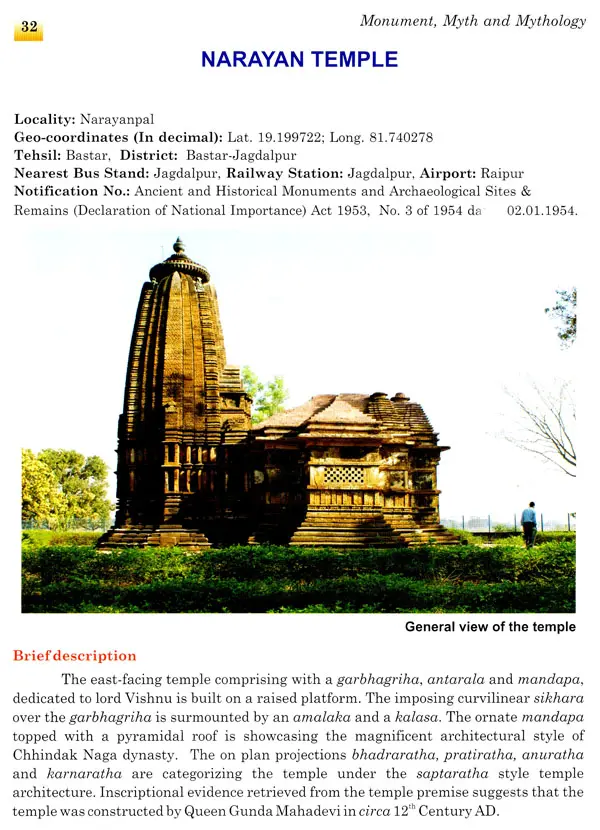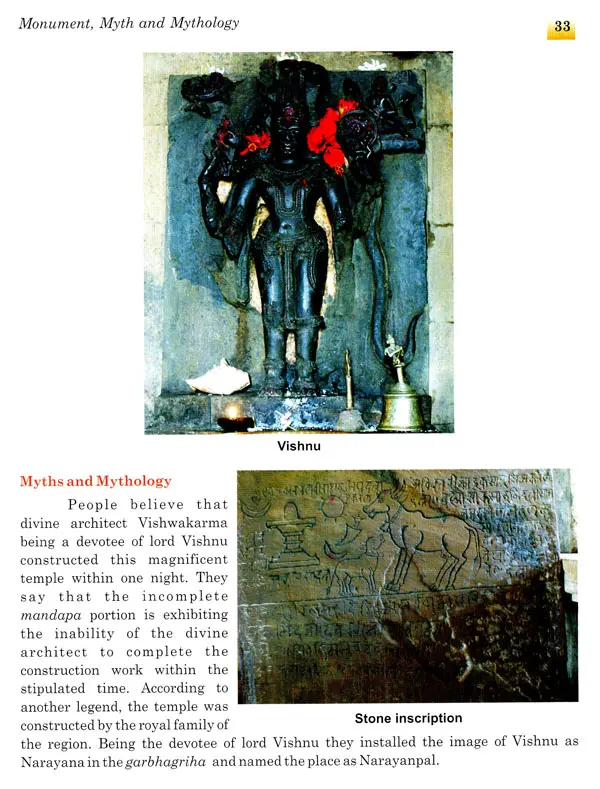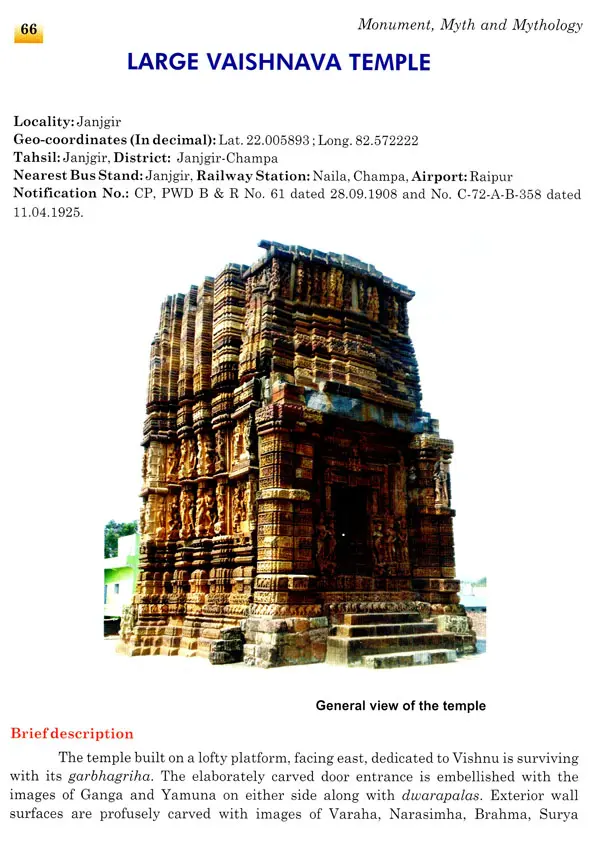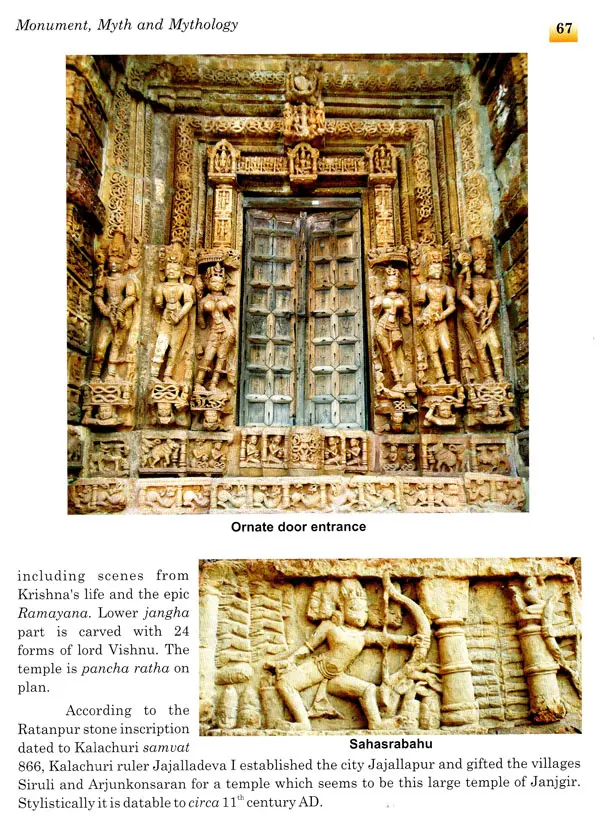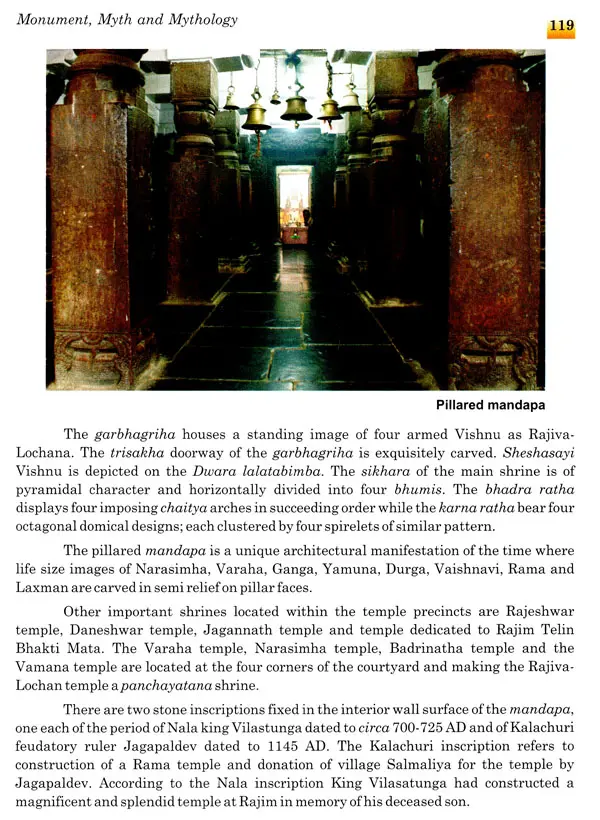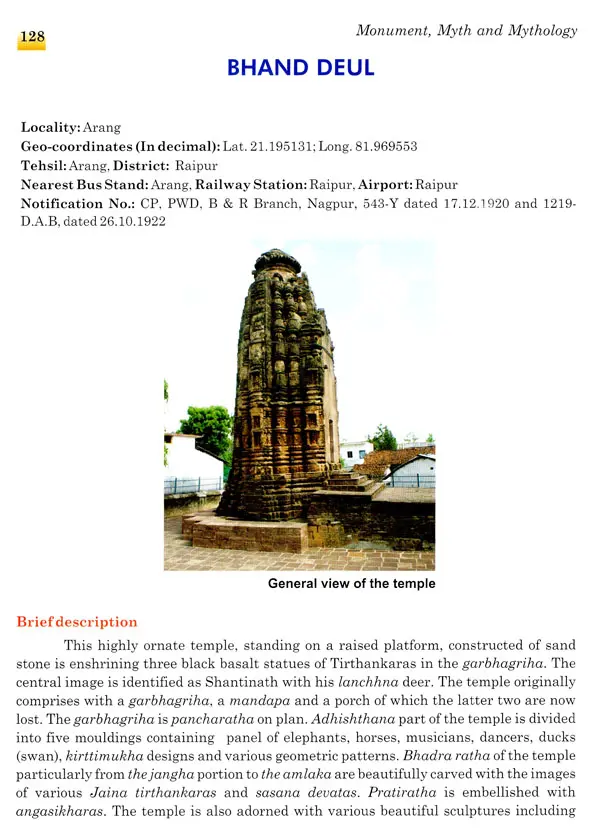
Monument, Myth and Mythology (With Special Reference to Centrally Protected Monuments of Chhattisgarh)
Book Specification
| Item Code: | UAP741 |
| Author: | DILLIP KUMAR KHAMARI |
| Publisher: | Aayu Publications, New Delhi |
| Language: | English |
| Edition: | 2017 |
| ISBN: | 9789385161643 |
| Pages: | 143 (Throughout Color Illustrations) |
| Cover: | HARDCOVER |
| Other Details | 10.00 X 7.50 inch |
| Weight | 510 gm |
Book Description
The monuments/sites are perhaps the finest example where one can see the blending of culture and mythological narrations with elements of regional thoughts and believes. The local culture, tradition and religious beliefs are so deep rooted and intermingled in our society that they can't be separated from each other. Storytelling has been the adopted mediums for conveying and transmitting messages from generation to generation in our society. These intangible heritages associated with our cultural properties are today facing challenges from urbanization and modernization and they are on the brink of their disappearance. Hence an attempt has been made by the author to document these intangible heritages, associated with the monuments and sites located in the state of Chhattisgarh.
Dr. Dillip Kumar Khamari obtained his first class Master Degree in Ancient Indian History from Sambalpur University, Odisha in 1992 He did his P.G. Diploma in Archaeology from the Institute of Archaeology, New Delhi in 1995 and joined in the Archaeological Survey of India as Assistant Archaeologist in 1997. He was awarded Ph.D in Ancient History and Archaeology on the topic "Archaeology of Sanchi in the light of recent discoveries from Madhya Pradesh Bhoj Open University in 2008. In 2012 he was directly selected as Superintending Archaeologist in the Archaeological Survey of India by the Union Public Service Commission. Presently he is serving as the Superintending Archaeologist of Raipur Circle, Raipur and holding the additional charges of Nagpur Circle, Nagpur and Excavation Branch-1, Nagpur.
He has participated in various excavations, explorations and setting up of archaeological museums of which mentions may be made to excavations at Dholavira, Lalkot, Golbai Sasan, Barabati, Sanchi, Udaigiri, Kulhadia, Hampi, Sirpur etc. As the Superintending Archaeologist of Excavation Branch-IV, Bhubaneswar he conducted exploration on the right bank of River Daya: The credit of discovering the well known Neolithic-Chalcolithic site at Suabarei, Odisha goes to him. After discovering the site in 2013 section scraping at the site was carried out by him and opined that the site would add a new dimension on the Neolithic Chalcolithic cultures particularly in coastal Odisha. He was true in his theory. Suabarei is the first such site in Odisha where a clear cut separate deposit of Neolithic and Chalcolithic period could be traced during regular excavations by the ASI. His recent conservation works in Chhattisgarh at Surang Tila, Sirpur, Ganesh Statues, Barsur; Chandraditya Temple, Barsur, Ratanpur Fort. Ratanpur and Group of temples, Tuman has added a new dimension to his academic career.
Story telling has been the adopted medium for conveying and transmitting messages from generation to generation in our society. The narrations of Bhagvad-Gita, Ramayana, Mahabharata or tales of Panchatantra, Jataka or various occasions. festivals or sometime the blind beliefs have been the content of these messages, being transmitted for centuries in the form of myths and local traditions or sculptural narrations depicted on religious or secular edifices. The local culture and tradition, mythology, believes and thoughts are so deep rooted and intermingled that they can't be separated from each other. Perhaps they represent to one basic thought and it seems our cultural wealth is the byproduct of this unique thought based on the prevailing myth and mythology.
The monuments in Chhattisgarh representing to about 2100 years of history especially from 3" century BC to 18" century AD, built under different political patronage are the repository of socio-cultural wealth of the state. The intangible heritage associated with these properties are today facing a lot of challenges and are on the brink of disappearance in the light of rapid urbanization and modernization.
Hence, this volume has been conceptualized to document all those living traditions associated with our cultural properties and to showcase the research outcome at one platter. The research has been restricted to the Centrally Protected Monuments located in the state of Chhattisgarh where the blending of culture and mythological narrations are seen with elements of regional thoughts and believes at its best.
It is indeed my pleasure to write the foreword of the present volume brought out by Dr. Dilip Kumar Khamari, showcasing the rich cultural heritage of Chhattisgarh. Apart from brief write ups and pictorial documentation of the ancient sites and monuments he has also endeavored to document the intangible aspects associated with the heritage, which are surviving in the form of local traditions and beliefs. The book is highlighting many unknown facets of monuments and their associated history. I am sure this would set up a new trend for the scholars and will certainly inspire all young officers of the ASI to come up with their perception of heritage and place it before the intellectual community, befittingly. I congratulate Dr. Dilip Kumar Khamari and his team for their endeavor and hope that it will serve as an important source book for the scholars, tourists and heritage managers interested in the heritage of Chhattisgarh.
The association of Chhattisgarh (Lat. 17 46-24°06' N: Long. 80°16-84 24 E), the 26 state of the Union of India, created in the year 2000 with mythology can be traced back to the days of Mahabharata and the Ramayana. The Dandakaranya' region referred in the epic Ramayana' is popularly identified with the Bastar area of Chhattisgarh, today mostly dominated by tribal population. The demographic records also suggest the dominance of various tribes such as the Baiga. Gond, Muriya. Bisonhorn Maria, Parghi Muria, Halba, Bhatra, Bhunjia, Parja, Dhurvan. Binjwar Savra, Manji, Kol, Korwa, Rajgond, Abujmaria, Kawar, Bhaiyana, Bhayna. Munda, Dorla, Dhanwar etc. in the region as well as in the state.
Watered by river Mahanadi, Seonath, Indravati and tributaries like Mand, Parry, Jonk, Rehand, Sabari, Kharun the state has witnessed the rise and fall of many cultures. Between c. 600 B.C. to 1800 A.D. the region was variously known as Kosala, Dakshina Kosala or Maha Kosala. Between this period it was part of the Maurya, Satavahana and Gupta empires besides the regional powers like the Sarabhapuriyas. Panduvamshi, Somavamshi, Kalachuri, Nagavamshi etc. dynasties. The Kalachuris enjoyed their supremacy over the state from 980 to 1741 AD. Between 1741 to 1845 AD, the state was under the Bhonsles of Nagpur.
The cultural edifices built under these political patronage, surviving through centuries in the state are the repository of cultural wealth where blending of native Indian culture and mythological stories are seen with elements of regional thoughts. The Sita Bengra and Jogimara Caves in the Ramgarh hills are outstanding monuments of early historical period found in Chhattisgarh. In the post Gupta period the Panduvamshis ruled over the state with its capital city at Sripura or modern Sirpur. Numerous structural remains of religious and secular character comprising temples, monasteries, dwelling houses, bazaars etc. are representing to their glorious epoch. Other important archaeological sites of this period in the state are found at Rajim, Malhar and Pujaripali. The glorious reign of Kalachuri dynasty is represented by the temples at Janjgir. Seorinarayan, Tuman, Pali, Narayanpur, Deobaloda. Gandai, Deorbija, Bhoram Deo (Chauragaon). Arang besides forts and palaces at Malhar, Ratanpur, Chaiturgarh, Kasigarh, Ajmeragarh, Kotgarh etc. During the rule of the Nagavamshi in Bastar region temples were erected at places like Narayanpal, Barsur, Samlur.
Book's Contents and Sample Pages

